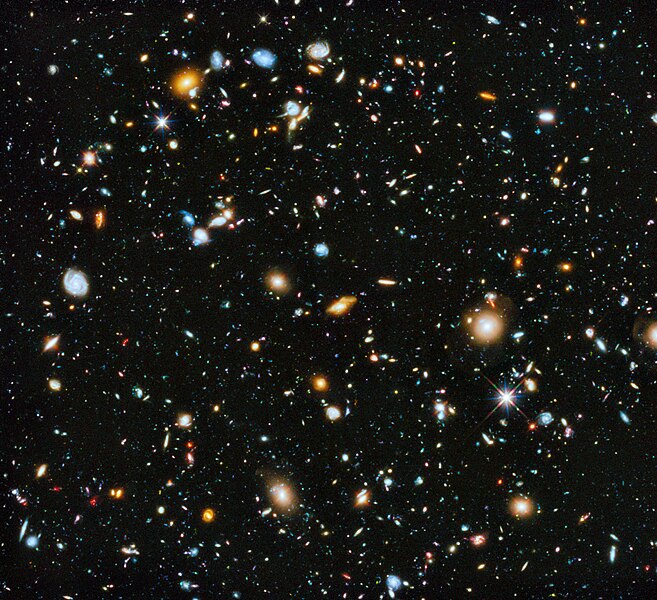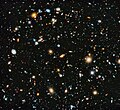File:NASA-HS201427a-HubbleUltraDeepField2014-20140603.jpg
Appearance

Size of this preview: 657 × 600 pixels. Other resolutions: 263 × 240 pixels | 526 × 480 pixels | 841 × 768 pixels | 1,122 × 1,024 pixels | 2,300 × 2,100 pixels.
Original file (2,300 × 2,100 pixels, file size: 6.9 MB, MIME type: image/jpeg)
| This is a featured picture, which means that members of the community have identified it as one of the finest images on the English Wikipedia, adding significantly to its accompanying article. If you have a different image of similar quality, be sure to upload it using the proper free license tag, add it to a relevant article, and nominate it. |
| This image was selected as picture of the day on the English Wikipedia for August 3, 2016. |
File history
Click on a date/time to view the file as it appeared at that time.
| Date/Time | Thumbnail | Dimensions | User | Comment | |
|---|---|---|---|---|---|
| current | 11:15, 4 June 2014 |  | 2,300 × 2,100 (6.9 MB) | Drbogdan | User created page with UploadWizard |
File usage
The following 61 pages use this file:
- 2014 in science
- Astronomical object
- Deity
- List of deep fields
- Pantheism
- Talk:Hubble Ultra-Deep Field
- User:Blackdiamand/warning
- User:Bojo1498
- User:Borjitasstoi
- User:Cricketer993
- User:DiaTiger
- User:Drbogdan/sandbox-timelines-01
- User:Goodtiming8871
- User:Hayden21803
- User:Heatherawalls/sandbox/6
- User:Huggums537
- User:Kerplunkster
- User:Knox490
- User:KomradeKalashnikov/Userboxes
- User:KomradeKalashnikov/Userboxes/Multiverse
- User:Letcreate123/Userboxes/biggestuserboxever
- User:Miles.527/sandbox
- User:RLO1729
- User:RLO1729/Agatha Christie Star
- User:RLO1729/Agatha Christie Star 2
- User:RLO1729/Header
- User:RLO1729/Smile
- User:RLO1729/Thanks
- User:RLO1729/Thanks/banners
- User:RLO1729/Universe
- User:RLO1729/Userboxes/
- User:RLO1729/sandbox
- User:Ramesty
- User:SeanOfTheDead112
- User:SomeoneIguess
- User:Uncyclopedia sux
- User:Wahrmund
- User talk:Crisco 1492/Archive 52
- User talk:Dbachmann/Archive 43
- User talk:Drbogdan/Archive 11
- User talk:Gullgate
- User talk:KomradeKalashnikov/Archive 1
- User talk:RLO1729
- Wikipedia:Featured picture candidates/August-2014
- Wikipedia:Featured picture candidates/Hubble Ultra Deep Field 2014
- Wikipedia:Featured picture candidates/Hubble Ultra Deep Field 2014 2
- Wikipedia:Featured pictures/Space/Looking out
- Wikipedia:Featured pictures thumbs/42
- Wikipedia:Main Page history/2016 August 3
- Wikipedia:Picture of the day/August 2016
- Wikipedia:Teahouse/Host landing
- Wikipedia:Teahouse/Hosts
- Wikipedia:WikiProject Astronomy/Recognized astronomy content
- Wikipedia:WikiProject Astronomy/Recognized content
- Wikipedia:WikiProject Physics
- Wikipedia:WikiProject Physics/Recognized content
- Wikipedia:WikiProject Spaceflight/Downlink/RCWatchlist
- Wikipedia:WikiProject Spaceflight/Recognized content
- Wikipedia talk:WikiProject Userboxes/New Userboxes/Archive 38
- Template:POTD/2016-08-03
- Portal:The arts/Recognized content
Global file usage
The following other wikis use this file:
- Usage on af.wikipedia.org
- Usage on am.wikipedia.org
- Usage on ar.wikipedia.org
- مجرة
- فضاء كوني
- ويكيبيديا:صور مختارة/الفضاء والكون/نظرة إلى الأعلى
- بوابة:علم الفلك/صورة مختارة
- حقل هابل العميق الفائق
- قائمة الحقول العميقة
- 2014 في العلوم
- ويكيبيديا:ترشيحات الصور المختارة/حقل هابل العميق الفائق 2014
- ويكيبيديا:صورة اليوم المختارة/أغسطس 2017
- قالب:صورة اليوم المختارة/2017-08-10
- بوابة:علم الفلك/صورة مختارة/30
- ويكيبيديا:صورة اليوم المختارة/أكتوبر 2021
- قالب:صورة اليوم المختارة/2021-10-16
- مستخدم:SalisaMAH49/ملعب
- Usage on arz.wikipedia.org
- كون
- 2MASX J12170738+3038358 (مجره)
- LEDA 213911 (مجره)
- 2MASX J12323613+1801234 (مجره)
- VVDS 140092139 (مجره)
- ESO 565 1 (مجره)
- LEDA 213770 (مجره)
- LEDA 1846725 (مجره)
- LEDA 1832164 (مجره)
- SDSS J101928.52+292302.3 (مجره)
- LEDA 101476 (مجره)
- NGC 1792 (مجره)
- NGC 63 (مجره)
- NGC 5248 (مجره)
- ESO 121 6 (مجره)
- NGC 4487 (مجره)
- NGC 4525 (مجره)
- ان جى سى 4551 (مجره)
- NGC 4564 (مجره)
- NGC 4691 (مجره)
- NGC 4694 (مجره)
- NGC 5147 (مجره)
- NGC 6673 (مجره)
- NGC 2502 (مجره)
- NGC 2640 (مجره)
- NGC 3073 (مجره)
- NGC 3681 (مجره)
- LEDA 4091710 (مجره)
- UGC 6181 (مجره)
- SDSS J125538.89 001553.6 (مجره)
- LEDA 4574306 (مجره)
- 6dFGS gJ221848.9 461303 (مجره)
- UGC 7824 (مجره)
View more global usage of this file.
